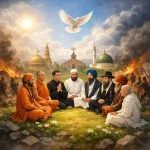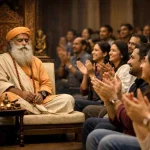Faith and Film: How Religion Is Depicted in Indian & Global Cinema in 2025
Cinema has always been more than entertainment; it is a mirror of human belief, struggle, and imagination. Religion — as one of the most powerful forces shaping human identity — has been a recurring theme in films across the world. From Indian epics to Hollywood dramas, filmmakers continue to explore how faith inspires, divides, and transforms lives. In 2025, this relationship between religion and cinema has entered a new era — one marked by bold storytelling, cultural sensitivity, and digital experimentation.
The Changing Language of Faith in Cinema
Earlier decades often portrayed religion in binaries — saints versus sinners, gods versus demons, believers versus skeptics. But 2025’s filmmakers are more interested in exploring the grey zones of faith. Instead of preaching, they are questioning. Instead of showing miracles, they are examining meaning. Religion is no longer just a backdrop for divine tales; it is a lens to explore human emotion, social tension, and moral dilemmas.
Indian cinema, for example, has moved beyond the mythological storytelling that dominated the 1950s and 60s. Today’s directors are using faith as a narrative tool to address modern issues — identity, gender, caste, ecology, and technology. Films like Tumbbad or OMG 2 earlier paved the way for nuanced depictions of belief systems. Now, in 2025, streaming platforms have become the new temples of storytelling, offering space for regional and experimental voices to reinterpret faith in contemporary settings.
India’s Spiritual Storytelling: Between Devotion and Dissent
India’s religious landscape is vast and layered, and its cinema reflects this diversity. In recent years, filmmakers have been daring enough to engage with controversial questions — how religion interacts with politics, how rituals evolve in urban life, and how spiritual leaders influence modern society.
New films in 2025 portray faith not as a monolith but as a lived experience — full of contradictions. A Hindi-language drama might explore the struggles of a young woman priest breaking gender barriers in a temple; a Tamil film might depict environmentalism as a new form of dharma; a Marathi web series could question blind faith through a story of social reform.
The growing trend of “devotional realism” blends sacred themes with everyday life. Viewers see not divine miracles but moral awakenings. Filmmakers are treating faith less as spectacle and more as soul — something personal, evolving, and deeply human.
At the same time, Indian cinema continues to celebrate its mythological heritage through grand visuals and technology. CGI-driven films inspired by the Ramayana, Mahabharata, and Shiv Puranas have found global audiences. However, these epics are no longer just retold; they are being reimagined — showing gods as flawed, relatable figures navigating human dilemmas. This balance between devotion and interpretation defines the cinematic faith of 2025.
Global Cinema and the Universal Quest for Meaning
Across the world, faith-based storytelling has also transformed. Hollywood and world cinema are exploring religion not through institutional power but through personal spirituality. The question has shifted from “Which religion is true?” to “What does it mean to believe?”
In Europe, filmmakers are examining the decline of organized religion and the rise of spiritual individualism. Scandinavian dramas, for instance, explore loneliness and the search for transcendence in a secular world. In the Middle East, directors are revisiting Islamic history with nuance — highlighting compassion, intellectual curiosity, and reformist voices. African cinema, meanwhile, merges indigenous spirituality with Christianity and Islam, presenting a unique blend of resilience and ritual.
American cinema has also broadened its scope. Films in 2025 often portray interfaith friendships, migrant spirituality, and digital religion — how apps, AI, and virtual rituals are reshaping belief. Streaming platforms like Netflix and Amazon Prime now fund documentaries about Buddhist monks in VR temples, Christian climate activists, and young Muslims navigating identity in Western societies. Faith has become a global conversation, and film is one of its most powerful languages.
The Rise of Interfaith and Inclusive Storytelling
One of the most positive shifts in recent cinema is the move toward interfaith and inclusive narratives. The world’s filmmakers are increasingly emphasizing empathy over exclusion. Instead of portraying religions in competition, they show how belief systems share universal values — compassion, justice, forgiveness, and peace.
Collaborations between Indian and foreign studios are exploring shared heritage themes — such as the Silk Road’s spiritual exchange or the migration of faith traditions across Asia. These projects show that religion in cinema is not just about identity; it’s about humanity’s shared longing for connection and purpose.
In India too, new independent films are highlighting stories where people of different faiths find common ground — in love, loss, or community life. This quiet interfaith realism stands in contrast to the loud religious politics often seen in news media. It reminds audiences that cinema, at its best, builds bridges where religion sometimes builds walls.
Technology, AI, and the Sacred Image
The visual representation of the divine has also changed dramatically. AI-assisted visuals, virtual reality sets, and immersive effects are now redefining how filmmakers depict gods, temples, and miracles. 2025’s mythological films use motion capture and 3D storytelling to make ancient epics emotionally relatable to younger audiences.
But this digital reinvention also raises ethical questions: Can faith be simulated? Does visual spectacle dilute spiritual depth? Filmmakers now face the challenge of keeping authenticity alive in an age of pixels and algorithms. Many are responding by grounding their stories in moral and emotional truth, even while embracing futuristic tools.
Conclusion: Faith as Film, Film as Faith
In 2025, the depiction of religion in cinema — both Indian and global — stands at a crossroads. The camera has become both a microscope and a mirror: zooming in on personal faith, reflecting the collective conscience. The best films today don’t preach religion; they evoke reflection. They turn belief into art and art into a form of belief.
Cinema, much like religion, has always sought to answer the same eternal questions — Who are we? Why do we suffer? What gives life meaning? As long as those questions remain, faith will continue to find its place on screen — not as propaganda, but as poetry.
~Religion World Bureau









